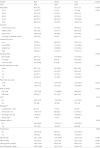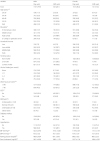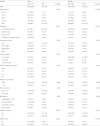1. Hansen J, Lassen CF. Nested case–control study of night shift work and breast cancer risk among women in the Danish military. Occup Environ Med. 2012; 69(8):551–556. DOI:
10.1136/oemed-2011-100240. PMID:
22645325.

2. Costa G. Shift work and occupational medicine: an overview. Occup Med. 2003; 53(2):83–88. DOI:
10.1093/occmed/kqg045.

4. Rosa RR, Colligan M. Plain language about shiftwork. 1997.
5. Alterman T, Luckhaupt SE, Dahlhamer JM, Ward BW, Calvert GM. Prevalence rates of work organization characteristics among workers in the US: data from the 2010 National Health Interview Survey. Am J Ind Med. 2013; 56(6):647–659. DOI:
10.1002/ajim.22108. PMID:
22911666.

6. Eurofound. Sixth European Working Conditions Survey–Overview Report. Publications Office of the European Union Luxembourg. 2016.
7. Bell-Pedersen D, Cassone VM, Earnest DJ, Golden SS, Hardin PE, Thomas TL, Zoran MJ. Circadian rhythms from multiple oscillators: lessons from diverse organisms. Nat Rev Genet. 2005; 6(7):544. DOI:
10.1038/nrg1633. PMID:
15951747.

8. Katzenberg D, Young T, Finn L, Lin L, King DP, Takahashi JS, Mignot E. A CLOCK polymorphism associated with human diurnal preference. Sleep. 1998; 21(6):569–576. DOI:
10.1093/sleep/21.6.569. PMID:
9779516.

9. Khan S, Duan P, Yao L, Hou H. Shiftwork-mediated disruptions of circadian rhythms and sleep homeostasis cause serious health problems. Int J Genomics. 2018; 2018:8576890. DOI:
10.1155/2018/8576890. PMID:
29607311.

10. Smith MR, Eastman CI. Shift work: health, performance and safety problems, traditional countermeasures, and innovative management strategies to reduce circadian misalignment. Nat Sci Sleep. 2012; 4:111. PMID:
23620685.
11. Puttonen S, Härmä M, Hublin C. Shift work and cardiovascular disease – pathways from circadian stress to morbidity. Scand J Work Environ Health. 2010; 36(2):96–108. DOI:
10.5271/sjweh.2894. PMID:
20087536.

12. Stevens RG, Hansen J, Costa G, Haus E, Kauppinen T, Aronson KJ, Castano-Vinyals G, Davis S, Frings-Dresen MH, Fritschi L, et al. Considerations of circadian impact for defining 'shift work' in cancer studies: IARC working group report. Occup Environ Med. 2011; 68(2):154–162. DOI:
10.1136/oem.2009.053512. PMID:
20962033.

13. Engel CL, Sharima Rasanayagam M, Gray JM, Rizzo J. Work and female breast Cancer: the state of the evidence, 2002–2017. New Solut. 2018; 28(1):55–78. DOI:
10.1177/1048291118758460. PMID:
29658425.

14. Kubo T, Oyama I, Nakamura T, Kunimoto M, Kadowaki K, Otomo H, Fujino Y, Fujimoto N, Matsumoto T, Matsuda S. Industry-based retrospective cohort study of the risk of prostate cancer among rotating-shift workers. Int J Urol. 2011; 18(3):206–211. DOI:
10.1111/j.1442-2042.2010.02714.x. PMID:
21332815.

15. Vogel M, Braungardt T, Meyer W, Schneider W. The effects of shift work on physical and mental health. J Neural Transm. 2012; 119(10):1121–1132. DOI:
10.1007/s00702-012-0800-4. PMID:
22488445.

16. Jha V, Wang AY-M, Wang H. The impact of CKD identification in large countries: the burden of illness. Nephrol Dial Transplant. 2012; 27:suppl-3. iii32–iii38.

17. McMullan CJ, Curhan GC, Forman JP. Association of short sleep duration and rapid decline in renal function. Kidney Int. 2016; 89(6):1324–1330. DOI:
10.1016/j.kint.2015.12.048. PMID:
27165820.

18. Remuzzi G, Perico N, Macia M, Ruggenenti P. The role of renin-angiotensin-aldosterone system in the progression of chronic kidney disease. Kidney Int. 2005; 68:S57–S65. DOI:
10.1111/j.1523-1755.2005.09911.x.

19. Sharifian A, Farahani S, Pasalar P, Gharavi M, Aminian O. Shift work as an oxidative stressor. J Circadian Rhythms. 2005; 3(1):15. DOI:
10.1186/1740-3391-3-15. PMID:
16379673.

21. Gaspari F, Perico N, Remuzzi G. Application of newer clearance techniques for the determination of glomerular filtration rate. Curr Opin Nephrol Hypertens. 1998; 7(6):675–680. DOI:
10.1097/00041552-199811000-00009. PMID:
9864664.

22. Lopez-Giacoman S, Madero M. Biomarkers in chronic kidney disease, from kidney function to kidney damage. World J Nephrol Urol. 2015; 4(1):57. DOI:
10.5527/wjn.v4.i1.57.

23. Levin A, Stevens PE, Bilous RW, Coresh J, De Francisco AL, De Jong PE, Griffith KE, Hemmelgarn BR, Iseki K, Kidney Disease LEJ. Improving global outcomes (KDIGO) CKD work group. KDIGO 2012 clinical practice guideline for the evaluation and management of chronic kidney disease. Kidney Int Suppl. 2013; 3(1):1–150. DOI:
10.1038/kisup.2012.73.
24. Norris KC, Williams SF, Nicholas SB, Agodoa LY. Current view on CKD risk
factors: traditional, noncommunicable diseases.diabetes, hypertension,
and obesity. In: Chronic Kidney Disease in disadvantaged populations. Edn:
Elsevier; 2017. p. 183.90.
25. Charles LE, Gu JK, Fekedulegn D, Andrew ME, Violanti JM, Burchfiel CM. Association between shiftwork and glomerular filtration rate in police officers. J Occup Environ Med. 2013; 55(11):1323–1328. DOI:
10.1097/JOM.0b013e3182a299c9. PMID:
24164760.

26. Lee S, McCann D, Messenger JC. Working time around the world. 2007. Geneva: ILO.
27. Centers for Disease Control and Prevention. Healthy Weight-About Adult BMI https://www.cdc.gov/healthyweight/assessing/bmi/adult_bmi/index.html.
28. Chobanian AV, Bakris GL, Black HR, Cushman WC, Green LA, Izzo Jr JL, Jones DW, Materson BJ, Oparil S, Wright Jr JT. The seventh report of the joint national committee on prevention, detection, evaluation, and treatment of high blood pressure: the JNC 7 report. Jama 2003, 289(19):2560–2571.
29. Boogaard P, Caubo M. Increased albumin excretion in industrial workers due to shift work rather than to prolonged exposure to low concentrations of chlorinated hydrocarbons. Occup Environ Med. 1994; 51(9):638–641. DOI:
10.1136/oem.51.9.638. PMID:
7951797.

30. Kang M-Y, Kwon H-J, Choi K-H, Kang C-W, Kim H. The relationship between shift work and mental health among electronics workers in South Korea: a cross-sectional study. PLoS One. 2017; 12(11):e0188019. DOI:
10.1371/journal.pone.0188019. PMID:
29145440.

31. Froy O, Chapnik N, Miskin R. The suprachiasmatic nuclei are involved in determining circadian rhythms during restricted feeding. Neuroscience. 2008; 155(4):1152–1159. DOI:
10.1016/j.neuroscience.2008.06.060. PMID:
18674595.

32. Yoshioka T, Rennke HG, Salant DJ, Deen WM, Ichikawa I. Role of abnormally high transmural pressure in the permselectivity defect of glomerular capillary wall: a study in early passive Heymann nephritis. Circ Res. 1987; 61(4):531–538. DOI:
10.1161/01.RES.61.4.531. PMID:
2443267.

34. Cai H, Harrison DG. Endothelial dysfunction in cardiovascular diseases: the role of oxidant stress. Circ Res. 2000; 87(10):840–844. DOI:
10.1161/01.RES.87.10.840. PMID:
11073878.

36. Pinkney JH, Stehouwer CD, Coppack SW, Yudkin JS. Endothelial dysfunction: cause of the insulin resistance syndrome. Diabetes. 1997; 46(Supplement 2):S9–S13. DOI:
10.2337/diab.46.2.S9. PMID:
9285492.

37. Perticone F, Maio R, Perticone M, Sciacqua A, Shehaj E, Naccarato P, Sesti G. Endothelial dysfunction and subsequent decline in glomerular filtration rate in hypertensive patients. Circulation. 2010; 122(4):379–384. DOI:
10.1161/CIRCULATIONAHA.110.940932. PMID:
20625109.

38. Ricardo AC, Knutson K, Chen J, Appel LJ, Bazzano L, Carmona-Powell E, Cohan J, Tamura MK, Steigerwalt S, Thornton JD, et al. The Association of Sleep Duration and Quality with CKD progression. J Am Soc Nephrol. 2017; 28(12):3708–3715. DOI:
10.1681/ASN.2016121288. PMID:
28912373.

39. Ohayon MM, Smolensky MH, Roth T. Consequences of shiftworking on sleep duration, sleepiness, and sleep attacks. Chronobiol Int. 2010; 27(3):575–589. DOI:
10.3109/07420521003749956. PMID:
20524802.

40. Hämmig O, Bauer G. Work-life imbalance and mental health among male and female employees in Switzerland. Int J Public Health. 2009; 54(2):88–95. DOI:
10.1007/s00038-009-8031-7. PMID:
19242653.

41. Saksvik IB, Bjorvatn B, Hetland H, Sandal GM, Pallesen S. Individual differences in tolerance to shift work–a systematic review. Sleep Med Rev. 2011; 15(4):221–235. DOI:
10.1016/j.smrv.2010.07.002. PMID:
20851006.
43. Rotenberg L, Portela L, Marcondes W, Moreno C, Nascimento C. Gender and diurnal sleep in night workers at a Brazilian industry. Shiftwork in the 21 st century challenges for research and. Practice. 2000:305–9.
44. Bøggild H, Burr H, Tüchsen F, Jeppesen HJ. Work environment of Danish shift and day workers. Scand J Work Environ Health. 2001:97–105.
45. Shankar A, Klein R, Klein BE. The association among smoking, heavy drinking, and chronic kidney disease. Am J Epidemiol. 2006; 164(3):263–271. DOI:
10.1093/aje/kwj173. PMID:
16775042.

46. Hill NR, Fatoba ST, Oke JL, Hirst JA, O’Callaghan CA, Lasserson DS, Hobbs FR. Global prevalence of chronic kidney disease–a systematic review and meta-analysis. PLoS One. 2016; 11(7):e0158765. DOI:
10.1371/journal.pone.0158765. PMID:
27383068.








 PDF
PDF Citation
Citation Print
Print



 XML Download
XML Download